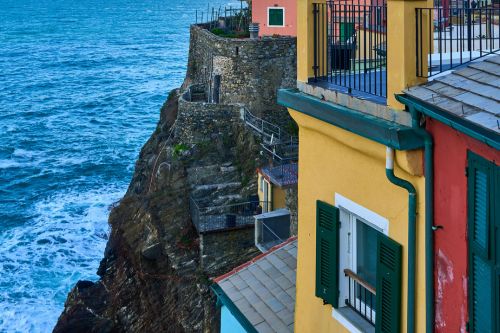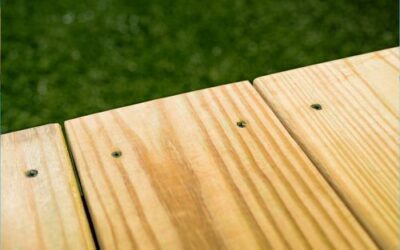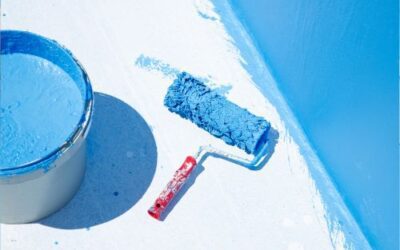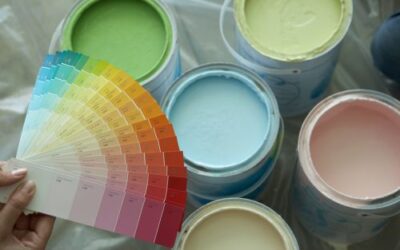The façades overlooking the sea are under constant tension. While holidaymakers enjoy the breeze and the sound of the waves, saltpetre is deposited on walls and railings, humidity penetrates through every micro-fissure and the sun, generous in hours and intensity, relentlessly punishes the pigments. It doesn’t matter whether the house is a villa facing the promenade or a building two streets from the shore: if it is within a kilometre radius, it shares the same enemies. That is why, before deciding on the shade of the exterior paint, it is important to know which formulas are most resistant to this marine environment and what care is needed to extend the life of the finish.
Contact our professionals
The challenge of painting on the coast
The sodium chloride that arrives in suspension with the salty air acts as a microscopic abrasive, becoming embedded in the pores and accelerating the degradation of the film. At the same time, the relative humidity rarely falls below 60 % and encourages the growth of algae and mould. Add UV radiation – much higher than inland – and thermal oversaturation cycles between day and night, and it is easy to understand why standard paint blisters, fades or flakes in a short time. We need coatings that can repel water without preventing the wall from ‘breathing’, that reflect part of the sun’s energy and that maintain their elasticity despite the constant expansion and contraction of the substrate.
Paints that really work in a marine environment
Among the many families available, there are seven that stand out for their durability:
Acrylic-siloxanic
These are the evolution of the classic acrylic paints. They combine good colour retention with a siloxane additive that acts as a molecular umbrella: rain runs off and the vapour inside escapes in the form of micropores. A façade coated with siloxane can easily withstand a decade with an almost intact tone, even at two or three hundred metres from the sea.
Solvent-based Pliolite®
This trade name resin penetrates plaster and mortar to great depths. It tolerates slightly damp substrates – a common occurrence when the mist soaks everything at dawn – and offers such high adhesion that many professionals consider it their ‘life insurance’ on the beachfront.
Waterproof elastomeric
Formulated with flexible acrylic resins, they follow the expansion of the wall without cracking. They are the preferred choice when micro-cracks already exist, as they cover them and prevent water from turning them into larger cracks. Their film is continuous and, at the same time, sufficiently breathable to avoid pockets of internal humidity.
Bi-component aliphatic polyurethane
If you need a finish with maximum hardness and colour stability – facades that are very exposed to impact from street furniture, for example – aliphatic polyurethane is a solid ally. It does not yellow in the sun and withstands chemical products and pressure cleaning without losing its shine.
Epoxy + polyurethane system
It is used when the level of aggression is extreme, such as on coastguards or docks. First an epoxy primer is applied to seal the pores and act as an anti-corrosion barrier, then an aliphatic polyurethane finish is applied to act as a UV shield. It will last more than ten years without repainting if the thickness is correct.
Mineral silicates
Perfect for stone or brick facades. Their resistance comes from the chemical reaction (petrification) that takes place between the silicate and the mineral support. They do not peel, because they do not form a film; they simply become part of the material. They are inorganic, breathable and practically incombustible.
Latest generation silicone resins
They combine the flexibility of acrylics with the extreme water repellency of silicones. Dirt adheres less – rain washes away salt deposits – and the colour lasts more than fifteen years, even in intense shades, provided that the recommended thicknesses are applied.
Variables that influence the choice
Not every house needs the most expensive solution or the most complex system. The real proximity to the sea (the seafront is not the same as five hundred metres inland), the type of support -concrete, single-layer, facing brick- and the presence of an air chamber condition the decision. Also the tone: very dark colours absorb more heat and dilate more strongly, so they require elastic films or ‘cool colour’ pigments that reflect part of the infrared spectrum. The budget has to be measured in annual cost: a cheap bucket that requires repainting after four years ends up being more expensive than a technical one that lasts for ten years.
Professional application: half the success
No matter how good the paint is, it fails if it is applied on salt, dust or algae. Initial cleaning with pressurised water and neutral detergent is essential, followed by crack cleaning and priming. The first coat is usually diluted to improve anchoring, while the second – and sometimes a third – is applied to the exact thickness specified in the technical data sheet. No more, which would cause crazing, and no less, which would leave areas with insufficient protection. All this should be done at an ambient temperature above 8°C, with relative humidity below 85% and avoiding painting in strong winds that can blow fresh saltpetre onto the still tender film.
Maintenance: repainting starts the following day
A well-protected coastal facade is not a forgotten facade. It should be checked every year for small blisters or flaking, lightly washed every two or three seasons to remove salt deposits and the expansion joints should be checked. Repainting, if a siloxane or polyurethane system has been chosen, can wait eight, ten or even twelve years, when the loss of colour is evident or new micro-cracks appear.
In conclusion, the sea is a privilege, but it comes with a toll for any building nearby. Investing in the right paint – and applying it with the right protocol – extends the life of the façade, keeps the house free of damp and reduces long-term costs. If you still have doubts about which product best suits your case, contact Bartolomé Bas Pinturas: our technical team will help you choose and achieve a finish that defies saltpetre, sun and humidity for many years to come.
Other publications that may interest you
How often should I re-treat the exterior wood?
Wood that lives outdoors faces a relentless script: UV radiation that discolours, rain that swells the fibre, saltpetre that dries it out and fungus that sets in as the protective film ages. The result is visible to the naked eye: the original colour fades, fine...
Waterproofing paint: what it is and when to apply it outdoors
Leaks don't usually give you any warning. One day you discover a dark spot behind the wardrobe or a corner of the ceiling with buckled paintwork and you realise that damp has been working quietly for some time. In climates with heavy rainfall or in homes close to the...
Colours that increase the feeling of space in small houses
You don't need to tear down partitions or do a complete renovation to make your house look bigger. In many cases, paint can completely transform the perception of space. Choosing the right colours not only brings harmony and light, but also creates the illusion of...




